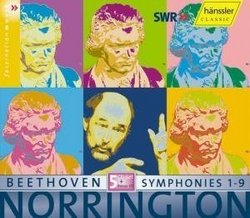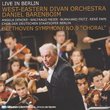| All Artists: Roger Norrington, SWR Stuttgart Radio Symphony Orchestra Title: Beethoven: Symphonies Nos. 1-9 (Box Set) Members Wishing: 0 Total Copies: 0 Label: Hanssler Classics Release Date: 5/24/2005 Album Type: Box set, Import Genre: Classical Styles: Historical Periods, Classical (c.1770-1830), Symphonies Number of Discs: 6 SwapaCD Credits: 6 |
Search - Roger Norrington, SWR Stuttgart Radio Symphony Orchestra :: Beethoven: Symphonies Nos. 1-9 (Box Set)
 | Roger Norrington, SWR Stuttgart Radio Symphony Orchestra Beethoven: Symphonies Nos. 1-9 (Box Set) Genre: Classical
|
Larger Image |
CD DetailsSimilar CDs |
CD ReviewsNorrington's 21st century update Larry VanDeSande | Mason, Michigan United States | 03/02/2007 (4 out of 5 stars) "I don't mind saying Roger Norrington renewed Beethoven for me. Before I sampled his first set of Beethoven symphonies about 1990, I had gone more than a decade being bored by Beethoven recordings. Of everything I'd heard, only the Symphony No. 9 by Richard Hickox on ASV, using an orchestra the size Beethoven would have known in his day, maintained my consistent interest. This probably because I overdosed on Beethoven as a young collector and overexposed myself to Beethoven a la Walter, Karajan, Bernstein, Toscanini, Szell, Bohm and Krips.
Norrington reenergized Beethoven for me in the same way he renewed his symphonies for an entire generation of classical music listeners. As one that came to classical music about 1970, the then recorded world of Beethoven revolved around two styles -- an older humanistic or romantic style best idealized by Walter and Furtwangler, and a newer objective or literal style best championed by Karajan, whose 1963 set of Beethoven symphonies is still probably the poster boy for the new style of worldwide conducting that emerged in the post-World War II era. With this new set, recorded in 2003 in concert recording with the Stuttgart Radio Symphony Orchestra using modern instruments, Norrington is the first period practitioner to have two complete sets of recordings of the nine Beethoven symphonies. In my mind, this set is the equivalent of Karajan's second complete set of recordings from 1977. There are similarities between the two -- both sets showed improved sonics and both showed the new Beethoven master still true to his style while rounding off some of the rough corners from his first address. In this set, Norrington improves his product over the 1985 version by: -- Having a cleaner, clearer sound that exposes all the instruments and instrumental lines. -- Exploiting the advantages of concert or "live" musicmaking by capturing the inherent spontaneity of those events. -- Offering much greater audial emphasis on timpani, which the conductor frequently uses to generate and maintain passion and momentum. -- Using an authentic old line German orchestra steeped in Beethoven tradition. The performances themselves are in no way, shape or character changed much from Norrington's first go round on EMI with the London Classical Players. He adheres to similar practices and tempi as the first time around. In my opinion there are some elements to these recordings that are not as good as the first time, however: -- The inclusion of audience applause after every performance. While I like applause, it begins to get tiresome when listening in sequence. Perhaps the set would have been better had applause been placed on an individual track. -- The "set" of symphonies is little more than placing the five individual recordings, in their jewel boxes with the original notes, inside a larger cardboard box. I'd have liked this better had Hanssler simply placed the CDs themselves in a new box with a single set of notes and documentation. This set takes up the same space as 7 CDs on your shelf. -- The inclusion of a separate CD with Norrington's chatter to the audience, before leading 8 of the symphonies, on historical practice. This is your "bonus" for buying the set. I suppose this is fine for people that like this sort of thing. Perhaps the greatest difference between this technically advanced set and Norrington's original set is the lack of discovery that comes with this one. Norrington shook the world in the 1980s with his first recordings and forced everyone to take notice in the same way Harnoncourt forced the world to look differently at Bach with his pioneering 1968 recording of the Brandenburg concertos. In the intervening decades Norrington has moved on to record Bach, Haydn, Mendelssohn, Schumann, Mahler and even Bruckner, typically to less acclaim. The bottom line is that, in spite of all the good and wonderful traits of this set, you heard it before in his earlier set. This was also true when Karajan came out with his 1977 Beethoven set. It sounded better, the conductor showed his personal growth in the interim period between the two productions, and he was still the biggest name in the business in the particular repertoire. But it did not carry the electric charge of the original set, which is still probably the best-selling Beethoven set in history. In recent months Gramophone magazine published a special story on Beethoven symphonies in light of recent sets by Abbado and Rattle and in-progress productions of the nine by Vanska-Minneapolis Symphony on BIS and Haitink-London Symphony on the LSO Live label. The magazine listed five sets of Beethoven symphonies is characterized as the most representative of the composer that were currently available; Karajan's 1963 set and Norrington's 1985 set were in that listing. While many readers protested their favorites not being represented in those choices, I agree with Gramophone's assessment. Furthermore, I'd say this set is the natural follow up to Norrington's still classic expose of what Beethoven has become in the PPP era." |

 Track Listings (8) - Disc #1
Track Listings (8) - Disc #1![Beethoven: Symphony No. 4; Symphony No. 7 [Hybrid SACD]](https://nationalbookswap.com/cd//m/30/3130/6163130.jpg)


